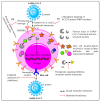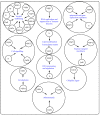Host Cell and SARS-CoV-2-Associated Molecular Structures and Factors as Potential Therapeutic Targets
- PMID: 34572076
- PMCID: PMC8467010
- DOI: 10.3390/cells10092427
Host Cell and SARS-CoV-2-Associated Molecular Structures and Factors as Potential Therapeutic Targets
Abstract
Coronavirus disease 19 (COVID-19) is caused by an enveloped, positive-sense, single-stranded RNA virus, referred to as severe acute respiratory syndrome coronavirus 2 (SARS-CoV-2), which belongs to the realm Riboviria, order Nidovirales, family Coronaviridae, genus Betacoronavirus and the species Severe acute respiratory syndrome-related coronavirus. This viral disease is characterized by a myriad of varying symptoms, such as pyrexia, cough, hemoptysis, dyspnoea, diarrhea, muscle soreness, dysosmia, lymphopenia and dysgeusia amongst others. The virus mainly infects humans, various other mammals, avian species and some other companion livestock. SARS-CoV-2 cellular entry is primarily accomplished by molecular interaction between the virus's spike (S) protein and the host cell surface receptor, angiotensin-converting enzyme 2 (ACE2), although other host cell-associated receptors/factors, such as neuropilin 1 (NRP-1) and neuropilin 2 (NRP-2), C-type lectin receptors (CLRs), as well as proteases such as TMPRSS2 (transmembrane serine protease 2) and furin, might also play a crucial role in infection, tropism, pathogenesis and clinical outcome. Furthermore, several structural and non-structural proteins of the virus themselves are very critical in determining the clinical outcome following infection. Considering such critical role(s) of the abovementioned host cell receptors, associated proteases/factors and virus structural/non-structural proteins (NSPs), it may be quite prudent to therapeutically target them through a multipronged clinical regimen to combat the disease.
Keywords: SARS-CoV-2; angiotensin-converting enzyme 2; coronavirus disease 19; pathogenesis; therapeutic targeting.
Conflict of interest statement
The authors declare no conflict of interest for this article.
Figures



Similar articles
-
SARS-CoV-2 host tropism: An in silico analysis of the main cellular factors.Virus Res. 2020 Nov;289:198154. doi: 10.1016/j.virusres.2020.198154. Epub 2020 Sep 9. Virus Res. 2020. PMID: 32918944 Free PMC article.
-
Distinctive Roles of Furin and TMPRSS2 in SARS-CoV-2 Infectivity.J Virol. 2022 Apr 27;96(8):e0012822. doi: 10.1128/jvi.00128-22. Epub 2022 Mar 28. J Virol. 2022. PMID: 35343766 Free PMC article.
-
SARS-CoV-2 Cell Entry Depends on ACE2 and TMPRSS2 and Is Blocked by a Clinically Proven Protease Inhibitor.Cell. 2020 Apr 16;181(2):271-280.e8. doi: 10.1016/j.cell.2020.02.052. Epub 2020 Mar 5. Cell. 2020. PMID: 32142651 Free PMC article.
-
Contributions of human ACE2 and TMPRSS2 in determining host-pathogen interaction of COVID-19.J Genet. 2021;100(1):12. doi: 10.1007/s12041-021-01262-w. J Genet. 2021. PMID: 33707363 Free PMC article. Review.
-
An Updated Review on Betacoronavirus Viral Entry Inhibitors: Learning from Past Discoveries to Advance COVID-19 Drug Discovery.Curr Top Med Chem. 2021;21(7):571-596. doi: 10.2174/1568026621666210119111409. Curr Top Med Chem. 2021. PMID: 33463470 Review.
Cited by
-
Cellular Immunology and COVID-19.Cells. 2021 Dec 20;10(12):3591. doi: 10.3390/cells10123591. Cells. 2021. PMID: 34944098 Free PMC article.
-
Impaired VEGF-A-Mediated Neurovascular Crosstalk Induced by SARS-CoV-2 Spike Protein: A Potential Hypothesis Explaining Long COVID-19 Symptoms and COVID-19 Vaccine Side Effects?Microorganisms. 2022 Dec 12;10(12):2452. doi: 10.3390/microorganisms10122452. Microorganisms. 2022. PMID: 36557705 Free PMC article. Review.
-
Insights into COVID-19 Vaccine Development Based on Immunogenic Structural Proteins of SARS-CoV-2, Host Immune Responses, and Herd Immunity.Cells. 2021 Oct 29;10(11):2949. doi: 10.3390/cells10112949. Cells. 2021. PMID: 34831172 Free PMC article. Review.
-
Exploring the Immunomodulatory Aspect of Mesenchymal Stem Cells for Treatment of Severe Coronavirus Disease 19.Cells. 2022 Jul 12;11(14):2175. doi: 10.3390/cells11142175. Cells. 2022. PMID: 35883618 Free PMC article. Review.
-
Finding potential inhibitors for Main protease (Mpro) of SARS-CoV-2 through virtual screening and MD simulation studies.Saudi J Biol Sci. 2023 Dec;30(12):103845. doi: 10.1016/j.sjbs.2023.103845. Epub 2023 Oct 20. Saudi J Biol Sci. 2023. PMID: 38020225 Free PMC article.
References
-
- Smith J.C., Sausville E.L., Girish V., Yuan M.L., Vasudevan A., John K.M., Sheltzer J.M. Cigarette Smoke Exposure and Inflammatory Signaling Increase the Expression of the SARS-CoV-2 Receptor ACE2 in the Respiratory Tract. Dev. Cell. 2020;53:514–529. doi: 10.1016/j.devcel.2020.05.012. - DOI - PMC - PubMed
Publication types
MeSH terms
Substances
LinkOut - more resources
Full Text Sources
Medical
Miscellaneous

